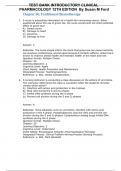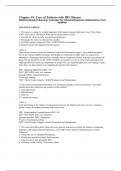Custojohnkeynes
On this page, you find all documents, package deals, and flashcards offered by seller custojohnkeynes.
- 83
- 0
- 6
Community
- Followers
- Following
89 items

TEST BANK INTRODU CTORY CLINICAL PHARMACOLOGY 12TH EDITION By Susan M Ford (41-54)
,TEST BANK INTRODUCTORY CLINICAL PHARMACOLOGY 12TH EDITION , By Susan M Ford chapter 41,42,43,44,45,46,47,48,49,50,51,52,53,&54
- Package deal
- • 14 items •
- Chapter 41, Pituitary and Adrenocortical Hormones TEST BANK INTRODUCTORY CLINICAL PHARMACOLOGY 12TH EDITION By Susan M Ford • Exam (elaborations)
- Chapter 42, Thyroid and Antithyroid Drugs TEST BANK INTRODUCTORY CLINICAL PHARMACOLOGY 12TH EDITION By Susan M Ford • Exam (elaborations)
- Chapter 43, Male and Female Hormones TEST BANK INTRODUCTORY CLINICAL PHARMACOLOGY 12TH EDITION By Susan M Ford • Exam (elaborations)
- Chapter 51: Immune Modulating Therapies TEST BANK INTRODUCTORY CLINICAL PHARMACOLOGY 12TH EDITION By Susan M Ford • Exam (elaborations)
- Chapter 52, Skin Disorder Topical Drugs TEST BANK INTRODUCTORY CLINICAL PHARMACOLOGY 12TH EDITION By Susan M Ford • Exam (elaborations)
- And more ….
,TEST BANK INTRODUCTORY CLINICAL PHARMACOLOGY 12TH EDITION , By Susan M Ford chapter 41,42,43,44,45,46,47,48,49,50,51,52,53,&54

Test Bank Medical Surgical Nursing 9th Edition Ignatavicius Workman (chapter 01-10)
Test Bank Medical Surgical Nursing 9th Edition Ignatavicius Workman chapter 1,2,3,4,5,6,7,8,9,&10
- Package deal
- • 10 items •
- Chapter 07: End-of-Life Care Test Bank Medical Surgical Nursing 9th Edition Ignatavicius Workman • Exam (elaborations)
- Chapter 01: Overview of Professional Nursing Concepts for Medical Surgical Nursing Test Bank Medical Surgical Nursing 9th Edition Ignatavicius Workman • Exam (elaborations)
- Chapter 10: Concepts of Emergency and Disaster Preparedness Test Bank Medical Surgical Nursing 9th Edition Ignatavicius Workman • Exam (elaborations)
- Test Bank Medical Surgical Nursing 9th Edition Ignatavicius Workman • Exam (elaborations)
- Chapter 08: Concepts of Emergency and Trauma Nursing MULTIPLE CHOICE Test Bank Medical Surgical Nursing 9th Edition Ignatavicius Workman • Exam (elaborations)
- And more ….
Test Bank Medical Surgical Nursing 9th Edition Ignatavicius Workman chapter 1,2,3,4,5,6,7,8,9,&10

Chapter 19: Care of Patients with HIV Disease Medical-Surgical Nursing: Concepts for Interprofessional Collaborative Care 9edition
MULTIPLE CHOICE 1. The nurse is caring for a client diagnosed with human immune deficiency virus. The clients CD4+ cell count is 399/mm3. What action by the nurse is best? a. Counsel the client on safer sex practices/abstinence. b. Encourage the client to abstain from alcohol. c. Facilitate genetic testing for CD4+ CCR5/CXCR4 co-receptors. d. Help the client plan high-protein/iron meals. ANS: A This client is in the Centers for Disease Control and Prevention stage 2 case definition gr...
- Package deal
- Exam (elaborations)
- • 11 pages •
MULTIPLE CHOICE 1. The nurse is caring for a client diagnosed with human immune deficiency virus. The clients CD4+ cell count is 399/mm3. What action by the nurse is best? a. Counsel the client on safer sex practices/abstinence. b. Encourage the client to abstain from alcohol. c. Facilitate genetic testing for CD4+ CCR5/CXCR4 co-receptors. d. Help the client plan high-protein/iron meals. ANS: A This client is in the Centers for Disease Control and Prevention stage 2 case definition gr...

Chapter 20: Care of Patients with Hypersensitivity (Allergy) and Autoimmunity Medical-Surgical Nursing: Concepts for Interprofessional Collaborative Care 9edition
:MULTIPLE CHOICE 1. A nurse works in an allergy clinic. What task performed by the nurse takes priority? a. Checking emergency equipment each morning b. Ensuring informed consent is obtained as needed c. Providing educational materials in several languages d. Teaching clients how to manage their allergies ANS: A All actions are appropriate for this nurse; however, client safety is the priority. The nurse should ensure that emergency equipment is available and in good working order and...
- Package deal
- Exam (elaborations)
- • 6 pages •
:MULTIPLE CHOICE 1. A nurse works in an allergy clinic. What task performed by the nurse takes priority? a. Checking emergency equipment each morning b. Ensuring informed consent is obtained as needed c. Providing educational materials in several languages d. Teaching clients how to manage their allergies ANS: A All actions are appropriate for this nurse; however, client safety is the priority. The nurse should ensure that emergency equipment is available and in good working order and...

Chapter 17: Inflammation and Immunity Medical-Surgical Nursing: Concepts for Interprofessional Collaborative Care 9edition
MULTIPLE CHOICE 1. The student nurse learns that the most important function of inflammation and immunity is which purpose? a. Destroying bacteria before damage occurs b. Preventing any entry of foreign material c. Providing protection against invading organisms d. Regulating the process of self-tolerance ANS: C The purpose of inflammation and immunity is to provide protection to the body against invading organisms, whether they are bacterial, viral, protozoal, or fungal. These system...
- Package deal
- Exam (elaborations)
- • 8 pages •
MULTIPLE CHOICE 1. The student nurse learns that the most important function of inflammation and immunity is which purpose? a. Destroying bacteria before damage occurs b. Preventing any entry of foreign material c. Providing protection against invading organisms d. Regulating the process of self-tolerance ANS: C The purpose of inflammation and immunity is to provide protection to the body against invading organisms, whether they are bacterial, viral, protozoal, or fungal. These system...

Chapter 18: Care of Patients with Arthritis and Other Connective Tissue Diseases Medical-Surgical Nursing: Concepts for Interprofessional Collaborative Care 9edition
MULTIPLE CHOICE 1. A nurse is working with a community group promoting healthy aging. What recommendation is best to help prevent osteoarthritis (OA)? a. Avoid contact sports. b. Get plenty of calcium. c. Lose weight if needed. d. Engage in weight-bearing exercise. ANS: C Obesity can lead to OA, and if the client is overweight, losing weight can help prevent OA or reduce symptom once it occurs. Arthritis can be caused by contact sports, but this is less common than obesity. Calcium an...
- Package deal
- Exam (elaborations)
- • 20 pages •
MULTIPLE CHOICE 1. A nurse is working with a community group promoting healthy aging. What recommendation is best to help prevent osteoarthritis (OA)? a. Avoid contact sports. b. Get plenty of calcium. c. Lose weight if needed. d. Engage in weight-bearing exercise. ANS: C Obesity can lead to OA, and if the client is overweight, losing weight can help prevent OA or reduce symptom once it occurs. Arthritis can be caused by contact sports, but this is less common than obesity. Calcium an...

Chapter 15: Care of Intraoperative Patients Medical-Surgical Nursing: Concepts for Interprofessional Collaborative Care 9edition
MULTIPLE CHOICE 1. The circulating nurse is plugging in a piece of equipment and notes that the cord is frayed. What action by the nurse is best? a. Call maintenance for repair. b. Check the machine before using. c. Get another piece of equipment. d. Notify the charge nurse. ANS: C The circulating nurse is responsible for client safety. If an electrical cord is frayed, the risk of fire or sparking increases. The nurse should obtain a replacement. The nurse should also tag the original...
- Package deal
- Exam (elaborations)
- • 8 pages •
MULTIPLE CHOICE 1. The circulating nurse is plugging in a piece of equipment and notes that the cord is frayed. What action by the nurse is best? a. Call maintenance for repair. b. Check the machine before using. c. Get another piece of equipment. d. Notify the charge nurse. ANS: C The circulating nurse is responsible for client safety. If an electrical cord is frayed, the risk of fire or sparking increases. The nurse should obtain a replacement. The nurse should also tag the original...

Chapter 16: Care of Postoperative Patients Medical-Surgical Nursing: Concepts for Interprofessional Collaborative Care 9edition
MULTIPLE CHOICE 1. A client has arrived in the postoperative unit. What action by the circulating nurse takes priority? a. Assessing fluid and blood output b. Checking the surgical dressings c. Ensuring the client is warm d. Participating in hand-off report ANS: D Hand-offs are a critical time in client care, and poor communication during this time can lead to serious errors. The postoperative nurse and circulating nurse participate in hand-off report as the priority. Assessing fluid ...
- Package deal
- Exam (elaborations)
- • 9 pages •
MULTIPLE CHOICE 1. A client has arrived in the postoperative unit. What action by the circulating nurse takes priority? a. Assessing fluid and blood output b. Checking the surgical dressings c. Ensuring the client is warm d. Participating in hand-off report ANS: D Hand-offs are a critical time in client care, and poor communication during this time can lead to serious errors. The postoperative nurse and circulating nurse participate in hand-off report as the priority. Assessing fluid ...

Chapter 14: Care of Preoperative Patients Medical-Surgical Nursing: Concepts for Interprofessional Collaborative Care 9edition
MULTIPLE CHOICE 1. An older client is hospitalized after an operation. When assessing the client for postoperative infection, the nurse places priority on which assessment? a. Change in behavior b. Daily white blood cell count c. Presence of fever and chills d. Tolerance of increasing activity ANS: A Older people have an age-related decrease in immune system functioning and may not show classic signs of infection such as increased white blood cell count, fever and chills, or obvious l...
- Package deal
- Exam (elaborations)
- • 11 pages •
MULTIPLE CHOICE 1. An older client is hospitalized after an operation. When assessing the client for postoperative infection, the nurse places priority on which assessment? a. Change in behavior b. Daily white blood cell count c. Presence of fever and chills d. Tolerance of increasing activity ANS: A Older people have an age-related decrease in immune system functioning and may not show classic signs of infection such as increased white blood cell count, fever and chills, or obvious l...

Chapter 11: Assessment and Care of Patients with Fluid and Electrolyte Imbalances Medical-Surgical Nursing: Concepts for Interprofessional Collaborative Care 9edition
MULTIPLE CHOICE 1. A nurse teaches clients at a community center about risks for dehydration. Which client is at greatest risk for dehydration? a. A 36-year-old who is prescribed long-term steroid therapy b. A 55-year-old receiving hypertonic intravenous fluids c. A 76-year-old who is cognitively impaired d. An 83-year-old with congestive heart failure ANS: C Older adults, because they have less total body water than younger adults, are at greater risk for development of dehydration. ...
- Package deal
- Exam (elaborations)
- • 11 pages •
MULTIPLE CHOICE 1. A nurse teaches clients at a community center about risks for dehydration. Which client is at greatest risk for dehydration? a. A 36-year-old who is prescribed long-term steroid therapy b. A 55-year-old receiving hypertonic intravenous fluids c. A 76-year-old who is cognitively impaired d. An 83-year-old with congestive heart failure ANS: C Older adults, because they have less total body water than younger adults, are at greater risk for development of dehydration. ...
